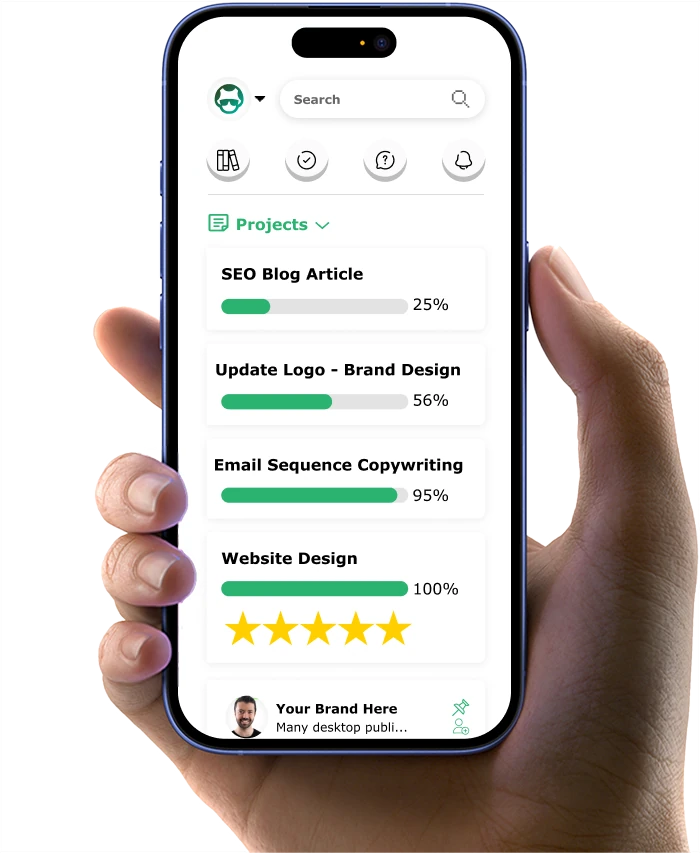How to (Not) Market with AI Slop: 5 Tips
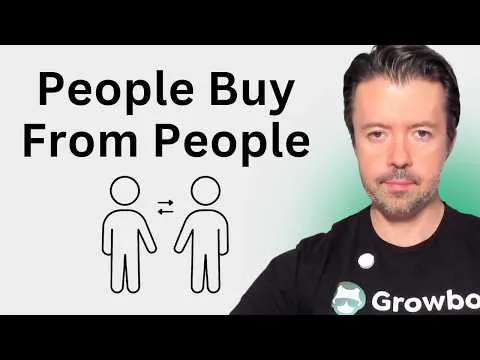
"To slop or not to slop, that is the question." I quoteth Shakespeare.
Nobody wants their brand to sound like a robot. Or worse—get completely ignored because their content feels cheap and fake.
If you've ever scrolled past an article that just "felt off," you're not alone.
I remember reading a blog post from a marketer I respected. Within seconds, I could tell it was AI-generated.
The tone was different. The style was different. It didn't teach anything.
Here's what most people don't realize: Your audience can tell. According to artsmart.ai, more than 50% of consumers engage less with content they believe is AI-generated.
That's a problem if you're using AI the wrong way.
But here's the good news: You don't have to fall into the "AI slop" trap. You can use AI in a smart way without cheapening your brand, and risk losing trust.
This video essay / article gives you five practical tips to keep your content fresh, authentic, and valuable. You'll learn exactly where AI helps and where it hurts.
Here's what you'll learn:
- The real reason you must stay in creative control while AI handles the grunt work
- A simple framework for knowing which marketing tasks to automate and which require human judgment
- Be authentic: Share real experiences and opinions. People trust people, not robots.
- Use AI as a helper, not a boss: Let it brainstorm ideas or check your spelling, but don’t let it _________write everything for you.
Let’s dive in…
Want to get all your marketing and funnel work done—without the headaches of hiring a team? Download our free guide: 33 Marketing Projects You Can Delegate to Growbo and discover how to save 100+ hours a month, grow faster, and scale without the overhead.
mention Terminator or some sci-fi movie. For most people, AI seemed decades away from becoming a real-world phenomenon.
But today, AI is everywhere. The progress since November 2022, when ChatGPT burst onto the scene, has been tremendous—but not always in a good way.
AI has become an invasive nuisance in online ecosystems and platforms.
From my own experience, customer service isn't better. If anything, it feels like another layer of bureaucracy.
YouTube is awash with automated channels, and it's hard to know if what you're watching was made by a person or a bot. If it's AI, I don't want to watch it. I don't value it. This is a huge part of the problem.
Google, seeing ChatGPT as a threat, quickly incorporated AI overviews into search and is nudging users toward "AI mode." The result? Businesses and website owners are getting 50% to 80% less traffic. That's a massive change.
Defining "AI Slop" Clearly
The phrase "AI slop" is powerful. I'm curious who first coined it, because there's a ton of it online today.
Sometimes it's funny—like the cat video where a father cat gets hit by a car and dies, leaving the son to grow up alone. But mostly, it's a problem.
The chart below perfectly captures why so many people are uneasy about where AI is headed. According to Microsoft’s Global Online Safety Survey:
- 71% of respondents worry about AI scams
- 69% are concerned about deepfakes and online abuse.
In total, 87% of people are anxious about at least one AI-related danger.
It’s no wonder “AI slop” has become such a hot topic—it’s a symptom of this growing mistrust.
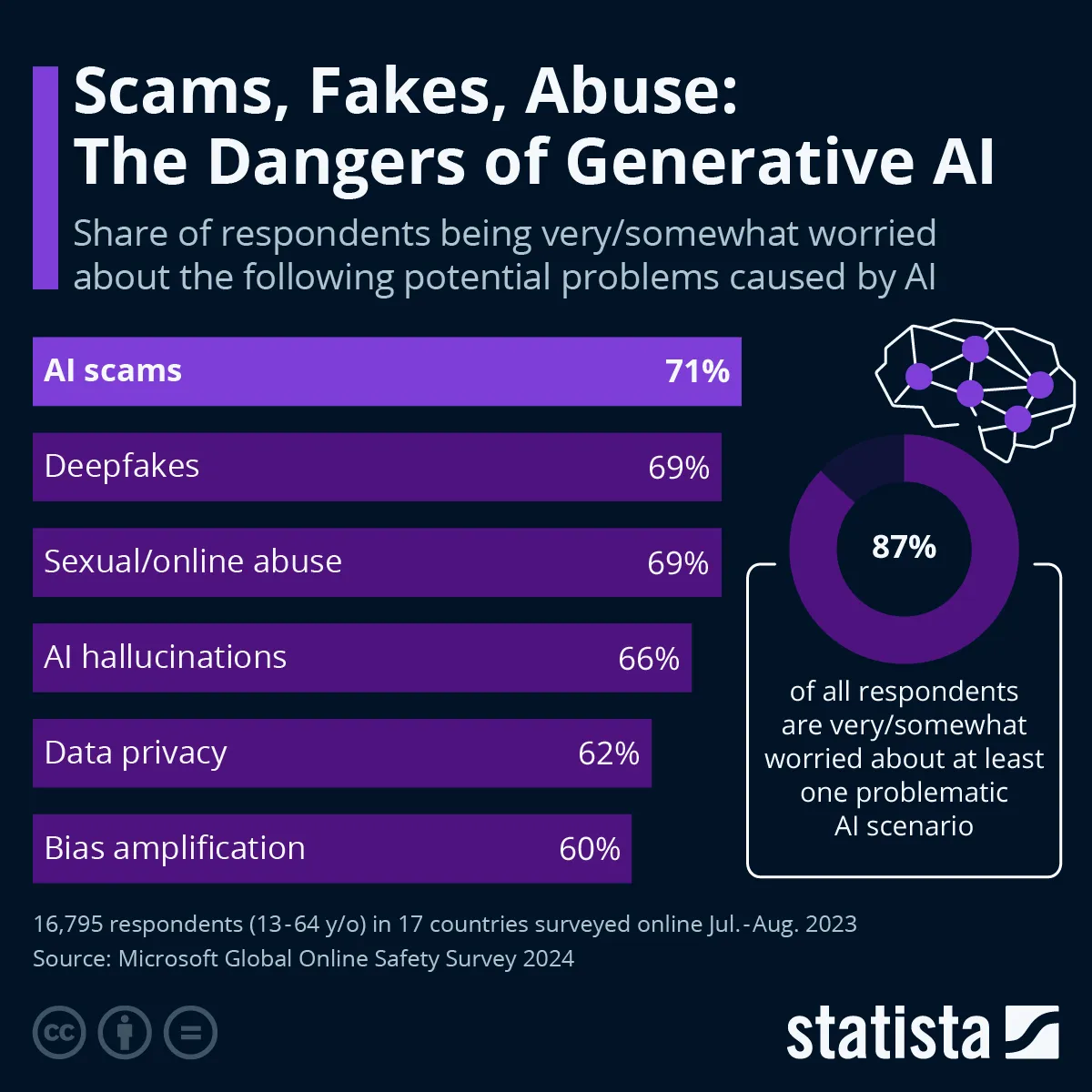
Let's get a working definition. According to Claud, “AI slop is low quality generic content that's mass-produced by AI with little to no human oversight or editing. It's typically bland, sometimes inaccurate, and often floods platforms or websites to game algorithms and generate quick revenue.”
Picture a recipe website filled with dozens of barely coherent articles like "10 best ways to cook chicken," each with awkward phrasing and weird, AI-generated images.
The site exists only to attract search traffic and show ads—not to help anyone cook.
The term "slop" conveys the idea of throwing low-effort content into a pig trough—cheap, mass-produced, and of questionable value. It's a concern because it can drown out high-quality, human-created content online.
Will AI Slop Drown Out Quality Content?
It remains to be seen. But platforms have strong incentives to keep users engaged, so they're developing detection tools with hidden markers to identify and filter AI-generated content.
You might chuckle at AI-generated biblical memes—Jesus scrolling an iPhone in the tomb, or Roman-era content. It's entertaining at first, but the novelty wears off real quick.
Once content is recognized as AI-made, there's this feeling that something is missing. What's missing? The inherent human value—judgment, taste, and human touch.
Here's the principle: If AI can generate infinite images or videos, the perceived value drops. Sure, a human might take hundreds of hours to create it. But when you realize AI does this millions of times per day for other people? You're over it.
What's interesting and novel about AI quickly loses its appeal—and therefore its value.
According to trendwatching.com, 59.9% of consumers now doubt online authenticity due to AI content flooding their feeds. And artsmart.ai found that 52% of consumers report reduced engagement with content they believe is AI-generated.
Human Touch Remains Essential
If you want to create something truly valuable, you need people with unique data sets, personalities, and tastes. Judgment, taste, and creativity are what make your content stand out.
For example: Would you rather get business advice from a coach who has actually built and sold a business, or from an AI chatbot trained on business coaching data? The coach's experience is unique and valuable.
The AI can summarize, but it can't replicate lived expertise.
The next chart really drives that point home. When marketers were asked what AI won’t be able to replace in their lifetime, nearly half said “engaging with sales prospects on a call.”
Other top answers included:
- Hiring and training employees
- Creating strategic plans, and
- Developing unique campaign ideas.
In other words, the most human parts of business—communication, creativity, and leadership—are still ours to own.
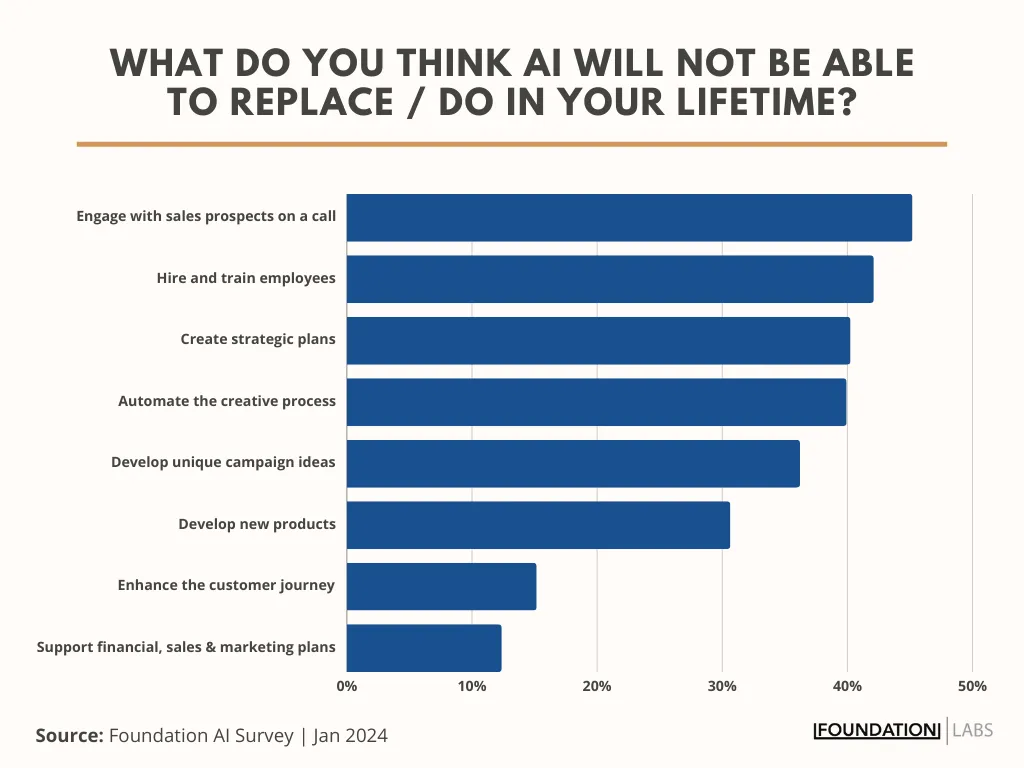
Tip #1: Don't Fully Embrace AI for Content Creation
A full embrace of AI for text, image, or audio content is out the window. You simply cannot do it.
It's tempting—especially when you hear success stories about early marketers growing their Instagram to a million followers using AI tools. Some early adopters have achieved success in certain verticals, and some already have.
But here's the problem: when everyone can do it, the novelty dies fast. The test you might want to run on social media will quickly lose its appeal.
The data supports this concern:
- Half of surveyed consumers can already correctly identify AI-generated content, and awareness is rapidly increasing (artsmart.ai)
- 60% of marketers using generative AI are concerned it could harm their brand reputation due to bias, plagiarism, or values misalignment
Think about it: if everyone adopts AI in the most practical ways, then really no one gains any special advantage. We're still going to need people with their own unique data, life experiences, personalities, and intriguing peculiarities.
We need tastemakers with that higher-order level of judgment—knowing that if you phrase something this way versus that way, it will be interpreted completely differently given the context, the market, what you're selling, to whom you're selling, and when.
Tip #2: Partial Embrace Can Work—But It Might Not
A partial embrace of AI in how you incorporate it into executing your marketing can work, but it also might not. You need to be aware that even partial use can potentially harm your brand.
A Real Example:
Take Neil Patel, a big-name brand in marketing. For many years, he published excellent articles that were well-written and well-edited.
I knew the articles weren't always him directly—the sheer volume was staggering over the years. He may have outlined them or helped edit them. I respect and admire him as an entrepreneur and marketer.
But the other month, he harmed his brand—at least in my eyes. An email came through that was clearly AI-generated.
It was difficult to tell from the email itself, but I clicked through and actually read the article. The tone was very different. The style was very different.
It didn't teach anywhere near as effectively as his articles used to when he and his team weren't using AI.
Why This Matters:
People are smart. People are more aware. AI is mainstream today.
When your audience starts questioning your content—noticing awkward wording or feeling like it's "bullshitting" them—they're being distracted from the actual benefit you intend them to get.
Instead of absorbing information, they're thinking: "What could have possibly written this? Oh, it's probably AI-edited or written."
Tip #3: You Are the Tastemaker—AI Is the Tool
This is the critical mindset shift: You are the tastemaker, AI is the tool.
Based on how AI works, it only gives you back something relative to how you use it, what you put into it, and what you request from it.
Use AI Incrementally:
You want to see AI as a tool to use incrementally in your business and marketing. Here's why you should NOT go all-in: In the future, everyone will have access to roughly equally powerful AI.
The more segments of your workflow that are dominated by AI—especially key segments that define and shape tone, nuanced details, personality, emotion, jokes, or little side commentary—the more you risk losing what makes you unique.
If everyone sounds the same because everyone is using AI to write in a similar manner and style, people will keep leveling up in their ability to detect AI-generated content.
How to Do This Right:
Look for something in your marketing workflow that is:
- Very repetitive
- Well-defined
- Requires low judgment
AI can work really well for those types of tasks. It frees up your time to focus on higher-value creative judgments—like the positioning of things, the color choices, and the wording of your copy.
My Task Complexity Guide:
- Low judgment, repetitive tasks: AI works well
- Medium levels of judgment and taste: Be very careful if you choose to incorporate AI
- High levels of taste, judgment, or complex tasks: I would say it's a no-go, at least for a while
Once again: You are the tastemaker. AI is the tool, and you want to proceed incrementally.
Tip #4: Use AI for Brainstorming, Ideas, Editing, and Research
These are some of the original use cases that made AI most popular—and they still work best.
Why These Use Cases Work:
In these scenarios, you're still positioned as the creative tastemaker. You know your product or service.
You know your market. Because if you're just relying on AI to create the bulk of everything and you're just skimming and scanning it, it's not going to work out well. It won't output something of quality.
The Right Approach:
Have AI start supplementing your work. Use it to amplify the message you would otherwise naturally give, in the tone and style you would naturally give it in.
You're not handing over creative control—you're using AI to help you think through ideas, refine your thoughts, improve your writing, and gather information faster.
Tip #5: If People Can Tell You're Using AI, You're Doing It Wrong
If people in your audience can tell from your marketing—videos, emails, website, ads—that you're using AI, they will generally care less and less over time. They'll convert less overall because of that cheapening effect as people become more aware and better able to spot what's AI versus what's not.
You're going to harm your brand. If people can tell you're marketing with AI and they're distracted by that fact, you've got to assume you're doing it wrong.
The Stock Photo Parallel:
This is similar to research I've read about stock photos. There are multiple A/B tested case studies that I've come across—they're part of our info product that we put together and have on our website called the Proven Sales Conversion Pack.
We sold this because it was hundreds of case studies packaged and analyzed and put together in a searchable database.
At least three of the case studies I came across talked about stock photos. They found that authentic photos—real, human photos—significantly outperformed stock photos.
Why? You know the ones: a guy in a suit like "I'm going to go to work," surrounded by other people who are just fake posing or whatever they're doing.
There's an idea being conveyed through the image, but what did people actually think? It felt commercial. People could ultimately spot those stock photos very easily over time.
People don't like what feels commercial. People like to buy from people.
The YouTube Channel Reality:
You can see it in terms of automated YouTube channels. There's all this hype around "oh, you could have a faceless YouTube channel and make tens of thousands of dollars or whatever."
Sure, for some, for now. But it's not going to last.
I mean, the channels that are sustainable are the ones that are inherently human—having a human face and a human touch to the copy, script, and delivery of everything.
Why This Matters:
People like to buy from other people. People want to connect with other people. People want to feel understood by other people.
This sense of understanding and connection comes through in content—or it doesn't if you're using AI.
The Bottom Line:
AI should enhance and amplify what is unique about your marketing content and the way you execute it. It should be adapted into your workflow incrementally, starting with use cases where the work is well-defined and requires low judgment.
If AI can easily do all of it, then all your competitors can rip you off in two seconds. The marketing gets tired faster, and you stand out less—blending in with other offers and other types of content.
Why Authenticity Wins Today
In a world where AI is everywhere, human connection and creativity are more valuable than ever. Audiences crave authenticity.
They want to buy from and connect with real people. If you rely too much on AI, you risk blending in, losing trust, and missing out on real engagement.
Just look at the chart that follows—it shows exactly why. When people were asked who gives better product recommendations, most said humans win because they can relate to needs better (60%) and have authentic, in-person knowledge (57%).
On the other hand, those who preferred AI said it’s faster and more precise. So while AI excels at efficiency, humans still dominate when it comes to trust, empathy, and real understanding.
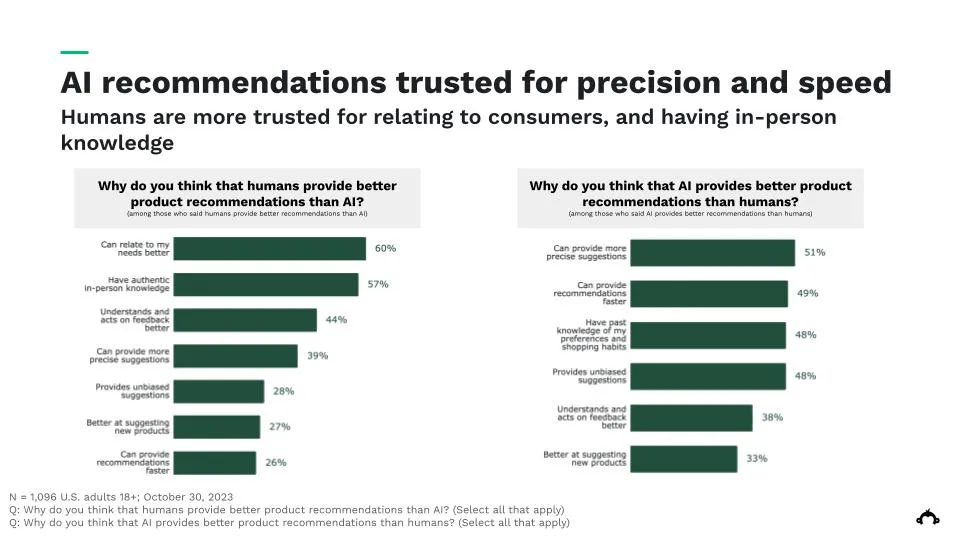
AI is a tool. Use it smartly and selectively. Let it amplify what makes your brand unique—not replace it.
And if you’re looking for a team that combines the best of both worlds, check out growbo.com. We provide an on-demand marketing fulfillment team of human professionals, using AI where it makes sense, but always putting everything through a human quality filter.
Final Thoughts
Want to get all your marketing and funnel work done—without the headaches of hiring a team? Download our free guide: 33 Marketing Projects You Can Delegate to Growbo and discover how to save 100+ hours a month, grow faster, and scale without the overhead.
To slop or not to slop? The answer is clear. Don’t let your marketing become seen as AI slop! Use AI wisely, thoughtfully, and always keep the human touch (taste, and judgement) at the center of your brand’s style and sense of voice.
If you found this valuable, I’d love to hear from you. Leave a comment, smash that like button, and check us out at growbo.com for more insights and support.
Remember: You are the tastemaker. AI is just your tool.
Keep Growing, Stay Focused,
Image Credits:
1. https://fusionchat.ai/news/analyzing-trends-from-alphabets-triumph-to-future-market-outlook
2. https://foundationinc.co/lab/ai-marketing-results/
3. https://foundationinc.co/lab/ai-marketing-results/
4. https://www.surveymonkey.com/curiosity/surveymonkey-research-ai-in-retail/



